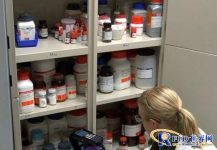
Oak Ridge National Laboratory uses UHF RFID tags to help chemical inventory
[ad_1]
Four years ago, Oak Ridge National Laboratory in the United States began to adopt RFID technology. After several years of continuous improvement, the laboratory has carried out inventory monitoring of its 1,200 individual storage areas. The RFID solution includes passive UHF RFID tags, handheld readers, label printers and software systems provided by Open Wave RFID. With the system installed, laboratory managers and researchers can perform inventory counts in hours, compared to days previously with barcode scanning.
Oak Ridge National Laboratory is the largest scientific energy laboratory under the US Department of Energy. It covers an area of 3,000 acres and is located in Oak Ridge, Tennessee. Its main research areas include neutron science, chemical and radiochemical technology, and energy science. Oak Ridge National Laboratory purchases about 25,000 new chemicals each year, and consumes the same amount of chemicals at the same time. Generally speaking, laboratory managers and scientific researchers need to perform inventory checks on a regular basis, which means that all containers containing chemicals such as glass bottles and metal cans need to be taken out of the lockers, and the barcodes need to be manually scanned for inventory data. Statistics are time-consuming and labor-intensive.

Inventory Counting with Handheld RFID Reader
The laboratory has been considering RFID technology since 2003, but the high cost of RFID tags has hindered the progress of application. In 2009, tag prices dropped to 20 cents a piece, and labs began investing in passive UHF tags, printers, and handheld readers.
Although the RFID system installed at first was much more efficient than barcode scanning, the 80% read/write rate could not meet the expected effect. For example, tags mounted on metal fixtures are difficult to read.
About two years ago, Oak Ridge National Laboratory began working with Open Wave RFID. The latter is an RFID solution provider headquartered in Chattanooga (a city in southeastern Tennessee, USA), dedicated to improving the accuracy of RFID reading and writing and the efficiency of data management. Open Wave has developed a system that extracts data from a laboratory’s existing Hazardous Chemicals Management System (HMMIS) and stores information such as the tag ID associated with the chemical. The system, called ChemVue, includes a Motorola 3190z handheld reader and RFID printer and UHF RFID tags.
The system was implemented at Oak Ridge National Laboratory in 2012. When a new chemical arrives, the data is first entered into the Hazardous Chemical Management System (HMMIS), and the printed RFID label is then affixed to the surface of the chemical container. The label is embedded with a unique ID code, and the QR code of the ID sequence is printed on the surface of the label.
To perform inventory inventory, managers upload inventory data from the backend server to the handheld reader through the docking station and the Open Wave software interface. Managers enter their ID number, which identifies the inventory area to be counted, and the Open Wave software displays all chemicals in that inventory area. Managers place the hand-held reader near the chemical to read the label information, and the software system will highlight the chemical that should be read but not read, or misplaced.
If it is lost, the manager can check the position of the item displayed on the handheld reader and check whether it is around. Alternatively, set the handheld reader to Geiger count mode and wave the reader around the storage area until you find the chemical you’re looking for.
After the inventory is over, the handheld reader will upload the read data to the HMMIS chemical management system through the Open Wave interface.
After the implementation of the inventory counting system based on RFID technology, 80% of the inventory counting time was saved. In the future, the laboratory plans to expand the application of RFID technology to waste material management.
[ad_2]



